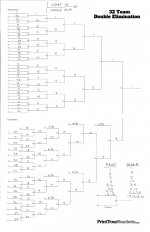There is a big problem with these brackets that change from double elimination to single elimination once down to the final 16. See the attached bracket (also in post below). I have simulated the bracket with all better seeded players winning (no upsets).
Here are the results:
First Place ---------------------- #1 Seed
Second Place ------------------ #9 Seed
Third Place --------------------- #2 Seed
Fourth Place ------------------- #10 Seed
Fifth/Sixth Place --------------- #3 & #4 Seeds
Seventh/Eighth Place -------- #11 & #12 Seeds
Ninth Thru Twelfth ------------- #5, #6, #7, #8 Seeds
Thirteenth Thru Sixteenth --- #13, #14, #15, #16 Seeds
This is not how brackets are supposed to work out. In order to do it correctly, they need to create a new bracket with the final 16 and reseed them all.
Also, there are several instances where it makes more sense for a player to intentionally lose early in order to go against a much easier field to make it to the finals.
(I discussed this in a different post but I thought it deserved a post of it's own)
Here are the results:
First Place ---------------------- #1 Seed
Second Place ------------------ #9 Seed
Third Place --------------------- #2 Seed
Fourth Place ------------------- #10 Seed
Fifth/Sixth Place --------------- #3 & #4 Seeds
Seventh/Eighth Place -------- #11 & #12 Seeds
Ninth Thru Twelfth ------------- #5, #6, #7, #8 Seeds
Thirteenth Thru Sixteenth --- #13, #14, #15, #16 Seeds
This is not how brackets are supposed to work out. In order to do it correctly, they need to create a new bracket with the final 16 and reseed them all.
Also, there are several instances where it makes more sense for a player to intentionally lose early in order to go against a much easier field to make it to the finals.
(I discussed this in a different post but I thought it deserved a post of it's own)
Attachments
Last edited:
